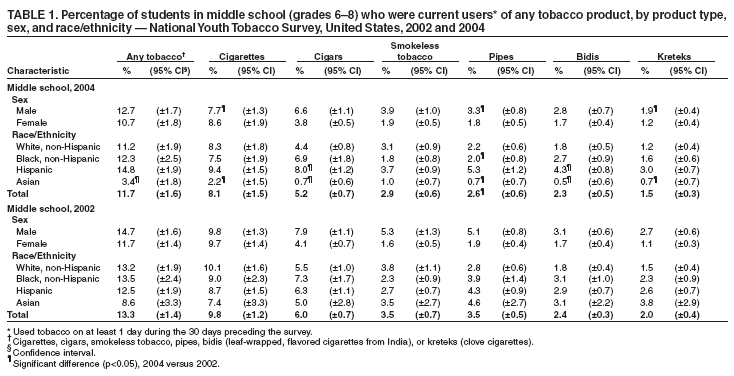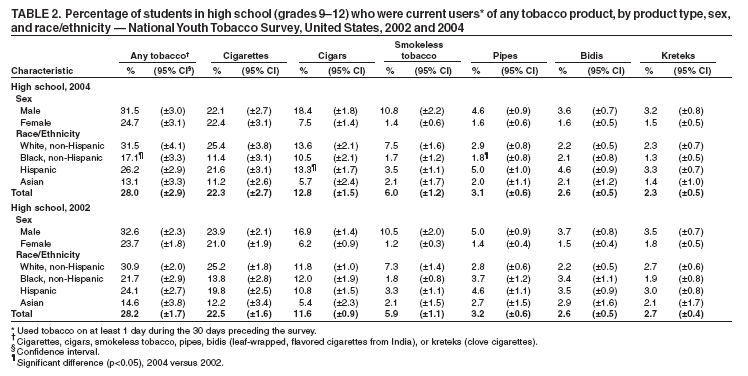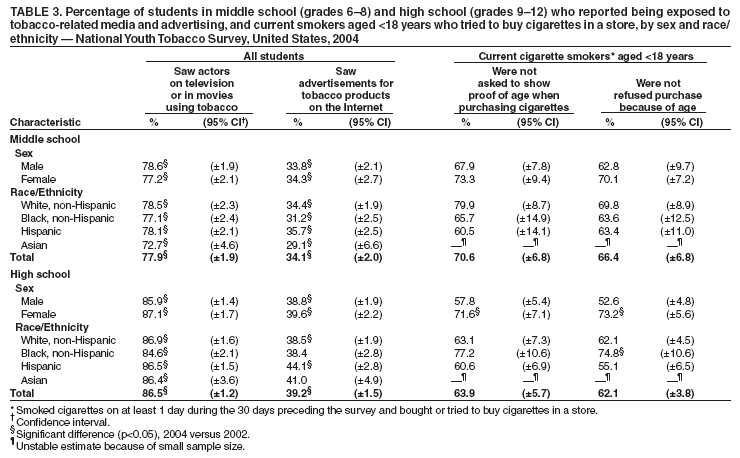 |
|
|
|
|
|
|
|
|
|
|
|
|
|
|
|
|
||||
| ||||||||||
|
|
|
|
Tobacco Use, Access, and Exposure to Tobacco in Media Among Middle and High School Students --- United States, 2004Please note: An erratum has been published for this article. To view the erratum, please click here.Two of the national health objectives for 2010 are to reduce the prevalence of any tobacco use during the preceding month to <21% and the prevalence of current cigarette use to <16% among high school students (objectives 27-2a and 27-2b) (1). The National Youth Tobacco Survey (NYTS), conducted by CDC in 2004, provided estimates of current use of tobacco products and selected indicators related to tobacco use, including youth exposure to tobacco-related media and access to cigarettes. This report summarizes data from the 2004 NYTS and describes changes in tobacco use and indicators related to tobacco use since 2002 (2). During 2002--2004, middle school students reported decreases in pipe use, seeing actors using tobacco on television or in movies, and seeing advertisements for tobacco products on the Internet. Among high school students, no changes were observed in the use of tobacco or in access to tobacco products; however, seeing actors using tobacco on television or in movies declined slightly, and seeing advertisements for tobacco products on the Internet increased. The lack of substantial decreases in the use of almost all tobacco products among middle and high school students underscores the need to fully implement evidence-based strategies (e.g., increasing the retail price of tobacco products, implementing smoking-prevention media campaigns, and decreasing minors' access as part of comprehensive tobacco-control programs) that are effective in preventing youth tobacco use (3). Similar to the 2002 NYTS (2), the sampling frame for the 2004 NYTS consisted of all U.S. public and private schools and was stratified by U.S. Census Bureau data by region and urbanicity; non-Hispanic black, Hispanic, and Asian students were oversampled. A total of 91 primary sampling units (PSUs) (i.e., large counties or groups of counties) were selected in the first stage of sampling, and 288 schools were selected from these PSUs in the second stage of sampling. Of these 288 eligible schools, 267 (93%) participated in the survey. In each school, typically five classes (approximately 125 students) were selected randomly from a required subject area (e.g., English) or a particular class period (e.g., all 2nd period classes). Participation was voluntary and anonymous, and school parental permission procedures were followed; students recorded their responses in a computer-scannable booklet. Of 31,774 students who were sampled from the participating schools, 27,933 (88%) completed the survey (14,034 middle school students [grades 6--8], 13,738 high school students [grades 9--12], and 161 students unclassified with respect to grade). Data were weighted to be nationally representative. Statistical software was used to compute 95% confidence intervals for prevalence estimates. Differences in tobacco use estimates during 2002--2004 were assessed by using t-tests at two-tailed significance level. All statistically significant results were p<0.05. Current use of specific tobacco products (i.e., cigarettes, cigars, smokeless tobacco, pipes, bidis [leaf-wrapped, flavored cigarettes from India], or kreteks [clove cigarettes]) was defined as having used that product on at least 1 day during the 30 days preceding the survey. Current use of any tobacco product was defined as having used any of the listed products on at least 1 day during the 30 days preceding the survey. Students were asked how often they saw actors using tobacco on television or in movies or saw advertisements for tobacco products on the Internet, whether they were asked for proof of age when they bought or tried to buy cigarettes in a store during the preceding 30 days, and whether anyone ever refused to sell them cigarettes because of their age during the preceding 30 days. In 2004, a total of 11.7% of middle school students reported current use of any tobacco product (Table 1). Cigarettes (8.1%) were the most commonly used product, followed by cigars (5.2%), smokeless tobacco (2.9%), pipes (2.6%), bidis (2.3%), and kreteks (1.5%). During 2002--2004, no significant changes were observed among middle school students in use of any tobacco or cigarettes (in 2002, a total of 13.3% of middle school students reported current use of any tobacco product, and 9.8% reported current use of cigarettes), cigars, smokeless tobacco, bidis, or kreteks. Pipe use declined significantly, from 3.5% to 2.6%. Among males, cigarette smoking and use of pipes and kreteks declined, from 9.8% to 7.7%, 5.1% to 3.3%, and 2.7% to 1.9%, respectively. Among Asians, use of any tobacco, cigarettes, cigars, pipes, bidis, and kreteks decreased. Among non-Hispanic blacks, use of pipes decreased. Among Hispanics, use of cigars and bidis increased significantly. In 2004, a total of 28.0% of high school students reported current use of any tobacco product (Table 2). Cigarettes (22.3%) were the most commonly used product, followed by cigars (12.8%), smokeless tobacco (6.0%), pipes (3.1%), bidis (2.6%), and kreteks (2.3%). During 2002--2004, no significant decreases were observed in use of any tobacco or use of a specific tobacco product (in 2002, a total of 28.2% of high school students reported current use of any tobacco product, and 22.5% reported current use of cigarettes). Among non-Hispanic blacks, use of any tobacco product and pipes decreased, from 21.7% to 17.1% and 3.7% to 1.8%, respectively. Among Hispanics, cigar use increased, from 10.8% to 13.3%. In 2004, a total of 77.9% of middle school students reported seeing actors using tobacco on television or in movies, and 34.1% reported seeing advertisements for tobacco products on the Internet (Table 3), compared with 89.9% and 42.7% in 2002, respectively. In addition, in 2004, a total of 70.6% of current cigarette smokers in middle school said they were not asked to show proof of age when they purchased or attempted to purchase cigarettes from a store, and 66.4% said they were not refused purchase of cigarettes because of their age. No significant differences were observed from 2002. During 2002--2004, a significant overall decline, from 91.3% to 86.5%, was observed among high school students who reported seeing actors using tobacco on television or in movies. However, a significant increase was observed, from 33.5% to 39.2%, in seeing tobacco products on the Internet. Among current smokers aged <18 years in high school, 63.9% said they were not asked to show proof of age when they purchased or attempted to purchase cigarettes from a store, and 62.1% said they were not refused purchase of cigarettes because of their age. No significant differences were documented from 2002. Reported by: AB Bloch, MD, PD Mowery, MA, RS Caraballo, PhD, AM Malarcher, PhD, T Pechacek, PhD, CG Husten, MD, Office on Smoking and Health, National Center for Chronic Disease Prevention and Health Promotion, CDC. R Carmona, MD, Office of the Surgeon General. Editorial Note:Preventing smoking initiation and use among adolescents is critical to ending the epidemic of tobacco use in the United States. In assessing state and national tobacco-control efforts, multiple indicators are needed to evaluate progress in reducing tobacco use among adolescents, in particular, measures of exposure to influences that promote or discourage tobacco use. NYTS serves as a national evaluation tool and as a benchmark for the 29 states that implemented a comparable state Youth Tobacco Survey in 2003 and 2004. Data from two of the multiple indicators in NYTS indicated no change occurred in minors' access to cigarettes, whereas declines in seeing actors using tobacco on television or in movies occurred among both middle and high school students. Although the levels of exposure to seeing actors using tobacco decreased from 91.3% in 2002 to 86.5% in 2004 among high school students and from 89.9% in 2002 to 77.9% in 2004 among middle school students, approximately three fourths of middle and high school students are still exposed to these images. Parental monitoring of and limitations on minors' access to media sources might reduce exposures (4); however, reductions in exposure large enough to effectively prevent smoking initiation might require different industry practices on smoking images in movies (5). Because the overall prevalence of any tobacco use or cigarette smoking did not change during 2002--2004 (2), data from future surveys will be important in determining whether progress toward meeting the national health objectives for 2010 is slowing. Several factors might be related to this lack of change in prevalence. From winter 1997 to spring 2002, the retail price of cigarettes increased approximately 80%, but from spring 2002 to spring 2004, the price increased only 4% (6). Although smoking-prevention media campaigns are effective in preventing youth smoking initiation (7), funding for these campaigns has declined substantially (8). In addition, during the preceding 3 fiscal years (FYs), a 28% decline in the total investment in statewide comprehensive tobacco-prevention and -control programs occurred, from $749.7 million in FY 2002 to $542.6 in FY 2004 (8). Finally, whereas factors preventing tobacco use (e.g., increasing the retail price of tobacco products, implementing smoking-prevention media campaigns, and funding for comprehensive state tobacco-prevention and -control programs) declined from 2002 to 2004, tobacco industry expenditures on tobacco advertising and promotion increased from $5.7 billion in 1997 to $12.5 billion in 2002 (9). The findings in this report are subject to at least three limitations. First, these data apply only to youths who attended middle school or high school. Among persons aged 16--17 years in the United States, approximately 5% were not enrolled in a high school program and had not completed high school in 2000 (2). Second, the questionnaire was offered only in English. Thus, comprehension might have been limited for students with English as a second language. Third, significance testing did not control for possible changes in demographics from 2002 to 2004. The decline in youth smoking prevalence since the late 1990s has been a public health success, reversing the pattern of increase in the early 1990s (2). However, the lack of substantial change among middle and high school students during the preceding 2 years emphasizes the need for sustained, comprehensive, evidence-based programs that demonstrate the ability to reduce adolescent smoking prevalence (10). Acknowledgments The findings in this report are based, in part, on contributions by KH Flint, MA, JG Ross, MS, R Iachan, PhD, WH Robb, MS, Macro International Inc., Calverton, Maryland. LL Pederson, PhD, K Jackson, MSPH, RTI International, Atlanta, Georgia. References
Table 1  Return to top. Table 2  Return to top. Table 3  Return to top.
Disclaimer All MMWR HTML versions of articles are electronic conversions from ASCII text into HTML. This conversion may have resulted in character translation or format errors in the HTML version. Users should not rely on this HTML document, but are referred to the electronic PDF version and/or the original MMWR paper copy for the official text, figures, and tables. An original paper copy of this issue can be obtained from the Superintendent of Documents, U.S. Government Printing Office (GPO), Washington, DC 20402-9371; telephone: (202) 512-1800. Contact GPO for current prices. **Questions or messages regarding errors in formatting should be addressed to mmwrq@cdc.gov.Page converted: 3/31/2005 |
|||||||||
This page last reviewed 3/31/2005
|